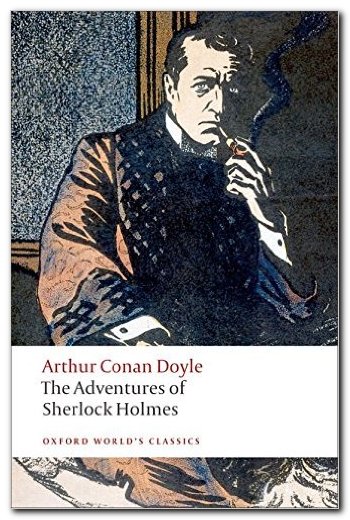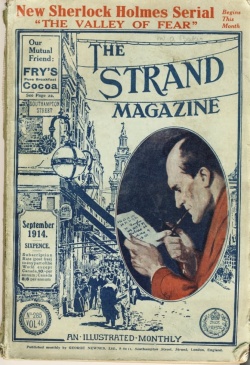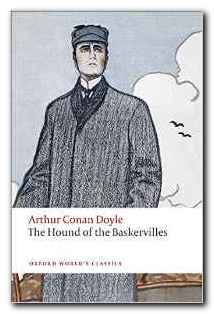tutorial, study resources, web links, and further reading
A Scandal in Bohemia was first published in July 1891 in The Strand Magazine with illustrations by Sydney Paget. As a stand-out character and detective hero, Sherlock Holmes had first appeared in Conan Doyle’s earlier novel A Study in Scarlet (1887) – but it wasn’t until the monthly stories appeared that the fictional character began to seize the public’s imagination. This effect was amplified by the publication in America in 1892 of these thirteen monthly episodes as The Adventures of Sherlock Holmes. This began a popularity for the figure of Holmes which continues to this day. There have been any number of radio, stage, and film adaptations of the stories, and there is currently a very successful television series in which the stories are transposed into present day settings.
A Scandal in Bohemia – critical commentary
Mise en scene
The setting, characters, and historical context of the story are all convincingly realistic. The story is set in a London that is thoroughly recognisable. Holmes lives in Baker Street in Marylebone, and Irene Adler in St John’s Wood. Many other places are mentioned – Edgware Road, Regent Street, and Charing Cross – and because they actually exist they help to establish realistic setting. Generations of tourists have walked up and down Baker Street searching for 221B – which is an invention on Conan Doyle’s part.
Watson gives an exact date at the start of the story – 20th March 1888. The king is from Bohemia, which was a separate state as part of the Austro-Hungarian empire during the nineteenth century – and still exists as part of the Czech Republic. He arrives in a ‘brougham’ – a Victorian horse carriage; and the driver is paid ‘half a guinea’. These details correspond to the historical picture we have of the world around that time and therefore make the background to the story seem credible.
The story is populated by a married doctor plus his friend and former flat-mate, an amateur detective. The other characters include a foreign aristocrat and an opera singer. Although Sherlock Holmes has unusually developed skills and Kings are not exactly commonplace, these characters form part of a world which seems reasonable, not unlike our own. They help to make the fictional world Conan Doyle offers us realistic.
The story begins in the streets of London, then continues to Holmes’ first floor apartment with its bachelor accoutrements of cigars and drinks cabinet. It moves on to the mews where servants are working, then a church in the Edgware Road and the avenue where Briony Lodge is situated. It reaches its climax inside the drawing room of the ‘bijou villa’ from which Irene Adler has recently decamped, and it ends as Watson and Holmes take to the streets of London again. All of these locations help to create a perfectly credible milieu.
The construction of character
The principal point of interest in the Sherlock Holmes stories and the reason that they have been so popular is the character of Holmes himself. The complete character study of Holmes can be best constructed from details about him which are scattered throughout the stories. However, from A Scandal in Bohemia alone we learn that he has an international reputation as a detective and is well known amongst European royalty. He has acute powers of observation and an ability to interpret visual data (see below). He is a master of disguise, and is able to transform his demeanour and actions into those of the person he is imitating.
In addition, he has an encyclopedic knowledge of society backed up by an archive of information on crime he keeps on index cards. He alternates between periods of lassitude which he spends in brooding reflection, and periods of dynamic activity in pursuit of his client’s problems.
Watson describes him as a man who ‘loathed every form of society with his whole Bohemian soul’ – which tells us that he is radically independent. He also has a ‘cold, precise, admirably balanced mind’. He is an intellectual, one who sneers at ‘the softer passions’ – which is what makes his admiration for Irene Adler such an exception. He is also given to offering witty, epigrammatic apercus such as “When a woman thinks that her house is on fire, her instinct is at once to rush to the thing she values most … A married woman grabs at her baby – an unmarried one reaches for her jewel box”.
Holmes is philosophical, brilliant, charismatic, benevolent and enigmatic. At the end of the story he shows a lofty disregard for the King by ignoring his handshake, and his non-materialistic values are revealed when he chooses the photo over the proffered emerald and gold ring.
One rather surprising detail we learn about him is that he is a cocaine addict – what we might today call ‘an occasional user’. Fortunately, this does not seem to hamper his powers as a detective, but it does reinforce the idea that he a social ‘outsider’. We learn in a later story that he also plays the violin. All of this adds up to making him a fascinating and complex individual. If we add to this picture his lean, angular appearance, the deerstalker hat, and the meerschaum pipe, it is not surprising that he has become an iconic figure in popular culture.
Deduction or induction?
But of course the most amazing thing about Holmes is the manner in which he able to combine acute observation with profound intelligence and an incisive system of reasoning to reach revealing insights and surprisingly deft conclusions. It is a method of ratiocination clearly modeled on Edgar Allen Poe’s detective Auguste Dupin.
Holmes analyses the watermarks of the paper on which the King has written his introductory note, and works out from the abbreviations that the paper has been produced in Bohemia. Then he goes on to look at the message itself and observes that though the writing is in English, it uses a distinctively German syntax – with a verb at the end of the sentence.
Amongst critics there is often disagreement on the question of Holmes’ methods of detection. He observes very small details of a person’s physical appearance or clothing, and from these details arrives at a general understanding of their occupation, their habits, or their recent movements. This method of detection illustrates his acute powers of observation and often reveals his encyclopedic knowledge of arcane topics – such as being able to recognise the ashes of different brands of cigar.
In Watson’s narrative, he calls Holmes’ method ‘deduction’ – “I could not help laughing at the ease with which he explained his process of deduction.” Watson (and by implication Conan Doyle) is employing the term in its everyday sense of seeing a relationship between one thing and another which doesn’t at first seem to be connected to it.
But the method, strictly speaking, is ‘induction’ – a form of reasoning which derives general principles from specific observation. This is also known as ‘bottom up’ reasoning. Holmes notices on Watson’s finger the marks of silver nitrate, which was originally used as a disinfectant and to cauterise wounds. From this he reasons that Watson has probably resumed his former occupation as a doctor.
Deductive reasoning works the other way round – and is known as ‘top down’ logic. This starts from a general principle then works down to a specific instance. All men are mortal; Socrates was a man; therefore Socrates was mortal. Another term for this process is ‘inference’. This is a minor issue – and many people accept and use the term ‘deduction’ for both forms of reasoning.
Close reading
Close reading is not a skill that can be acquired in just a few minutes. It requires detailed attention to language, wide literary experience, and concentrated reflection on the technical minutiae of texts. These strands of analysis need to be brought together many times over. The skill also involves consideration of a text in at four levels – linguistic, semantic, structural, and cultural. That is – the words of a text in their grammatical sense; what the words mean in the context of the story; what links they might have with the overall structure of the work; and the broader meanings of the text in terms of cultural history.
In one sense close reading is quite like the analytic method used by Sherlock Holmes himself. It squeezes the maximum amount of meaning out of quite small observations. For instance what follows is a close reading of the opening sentence of the story: ‘To Sherlock Holmes she is always the woman’. And in fact my observations will focus on just two words in the sentence ‘is’ and ‘the‘.
Linguistic. The use of the present tense – ‘she is’ – strikes an interesting note here. Most fiction is narrated in the past tense, but the present tense is sometimes used to give a sense of immediacy and urgency. This effect is reinforced here by the brevity and directness of the sentence. It starts the story on a bright note.
Semantic. The term ‘is’ also suggests something else here – that the high regard and rivalry between Sherlock Holmes and Irene Adler has originated in the past but is still going on in the fictional present of the story. This is reinforced by the addition of the adverb ‘always’. Yet we learn from Watson at the end of the paragraph that she is the late Irene Adler. It is not clear if this means she is dead or that the episode recorded in the story simply took place in the past. Either way, the fact remains that she continues to have an influence on him
Structural. The opening sentence of the story is rather neatly echoed by the sentence with which it ends: ‘When he speaks of Irene Adler … it is always under the honourable title of the woman. This small structural link using repetition introduces an element of symmetry or pattern into the narrative, making it coherent and satisfying. It is an indication that the story is well designed.
Cultural. At the end of the Victorian and the beginning of the Edwardian period there were a number of male writers who produced work which featured a woman who is idealised, inaccessible, mysterious, and often either beautiful or cruel – or both. One thinks of Rider Haggard’s She (1886-87) or many of the stories of Joseph Conrad and Somerset Maugham.
This was a period in which women were becoming more socially and personally assertive – claiming the right to own property and the right to vote for instance. Holmes’ reverence for Irene Adler – a talented, enterprising, and clever woman – reflects this broader historical development, all in just two words – ‘the woman’.
A Scandal in Bohemia – study resources
![]() The Adventures of Sherlock Holmes – Oxford Classics – Amazon UK
The Adventures of Sherlock Holmes – Oxford Classics – Amazon UK
![]() The Adventures of Sherlock Holmes – Oxford Classics – Amazon US
The Adventures of Sherlock Holmes – Oxford Classics – Amazon US
![]() The Complete Sherlock Holmes – Penguin – Amazon UK
The Complete Sherlock Holmes – Penguin – Amazon UK
![]() The Complete Sherlock Holmes – Penguin – Amazon US
The Complete Sherlock Holmes – Penguin – Amazon US
![]() The Adventures of Sherlock Holmes – Wordsworth – Amazon UK
The Adventures of Sherlock Holmes – Wordsworth – Amazon UK
![]() The Adventures of Sherlock Holmes – Wordsworth – Amazon US
The Adventures of Sherlock Holmes – Wordsworth – Amazon US
![]() Sherlock Holmes – 1939 classic DVD box set – Amazon UK
Sherlock Holmes – 1939 classic DVD box set – Amazon UK
![]() Sherlock – 2014 DVD box set – Amazon UK
Sherlock – 2014 DVD box set – Amazon UK
A Scandal in Bohemia – explanatory notes
| gasogene | a soda syphon |
| vizard | a half mask covering just the eyes |
| cabinet photograph | small portrait, which replaced the visiting card |
| John Hare | a famous English actor-manager |
| iodoform | antiseptic compound of iodine |
A Scandal in Bohemia – plot summaries
Short summary
Sherlock Holmes, a famous detective, is commissioned by the King of Bohemia to retrieve a potentially compromising photograph from Irene Adler, his former mistress. Holmes sets out in disguise to search her house but is sidetracked when he becomes caught up as a witness at her wedding. Later he returns and tricks her into revealing the hiding place. When he goes back next day however she has left a note saying she perceived his ruse and has emigrated, taking the photograph with her.
Long summary
Doctor Watson calls on his old flat mate in Baker Street, London. Sherlock Holmes is a famous detective with amazing powers of observation. They are visited by the hereditary King of Bohemia who is about to be married but is being blackmailed by Irene Adler, an opera singer with whom he has had an affair. She is threatening to reveal a compromising photograph.
Next day Watson visits Holmes who has been making a reconnaissance of Adler’s house whilst in disguise. Holmes learns that Adler has an admirer Godfrey Norton who is a lawyer. Norton and Adler leave the house hurriedly and Holmes follows them to a church, where he is pressed into acting as a witness to their marriage.
Holmes plans to make an illegal entry into the house the same night, and enlists Watson’s help. Disguised as a clergyman, he is at the house when a pre-arranged fight breaks out in the street. He dashes to protect Adler, and appears to be badly injured. He is taken into the house to recover, where he signals to Watson, who throws a smoke bomb into the house and raises the cry of ‘Fire!’. Ten minutes later, as they leave, Holmes explains how Adler revealed the hiding place of the photo.
Next morning the King accompanies them to Adler’s house, but she has already left England, never to return. She has left a letter for Holmes explaining that she recognised him and his methods, and she has retained the photo as a guarantee against any future action from the King.
A Scandal in Bohemia – further reading
Biography
John Dickson Carr, The Life of Sir Arthur Conan Doyle, London: John Murray, 1949.
Michael Coren, The Life of Sir Arthur Conan Doyle, London: Bloomsbury, 1995.
John L/ Lellenberg, The Quest for Sir Arthur Conan Doyle, Southern Illinois University Press, 1987.
Andrew Lycett, Conan Doyle: The Man Who Created Sherlock Holmes, London: Weidenfeld and Nicolson, 2008.
Pierre Nordon, Conan Doyle: A Biography, London: John Murray, 1966.
Hesketh Pearson, Conan Doyle – His Life and Work, London: Methuen, 1943.
Julian Symons, Portrait of an Artist: Conan Doyle, London: Whizzard Press, 1979.
Criticism
Don Richard Cox, Arthur Conan Doyle, New York: Ungar, 1985.
Owen Dudley Edwards, The Quest for Sherlock Holmes, Edinburgh: Mainstream, 1983.
Trevor Hall, Sherlock Holmes: Ten Literary Studies, London: Duckworth, 1969.
Michael and Mollie Hardwick, The Sherlock Holmes Companion, London: John Murray, 1962.
Howard Haycraft, The Art of the Mystery Story, Caroll & Graf Publishers, 1983.
Harold Orel (ed), Critical Essays on Sir Arthur Conan Doyle, G.K. Hall & Co, 1992.
Julian Symons, Bloody Murder, London: Faber, 1972.
Robin Winks, The Historian as Detective, London: Harper Collins, 1969.
Jaqueline A. Yaffe, Arthur Conan Doyle, Boston: Twayne, 1967.
A Scandal in Bohemia – web links
![]() Sherlock Holmes at Wikipedia
Sherlock Holmes at Wikipedia
Comprehensive biographical notes on the detective, extracted from all the stories and novels.
![]() The Sherlock Holmes Society of London
The Sherlock Holmes Society of London
An active literary and social society with special events, a journal, meetings, newsletter, and shop.
![]() Discovering Sherlock Holmes
Discovering Sherlock Holmes
Repository at Stanford University – includes facsimile reproductions of stories from the original Strand Magazine
© Roy Johnson 2016
More 19C Authors
More on literature
More on the novella
More on literary studies
More on short stories



